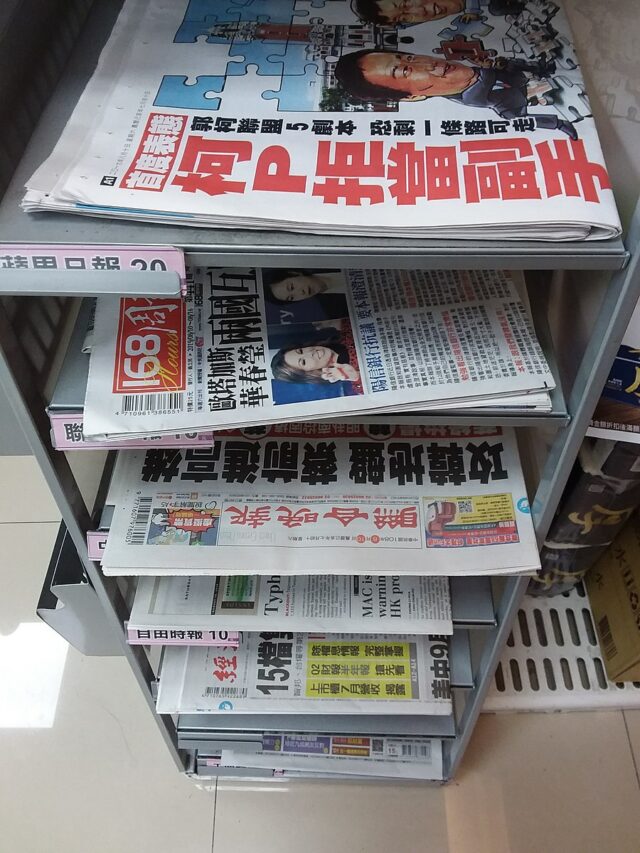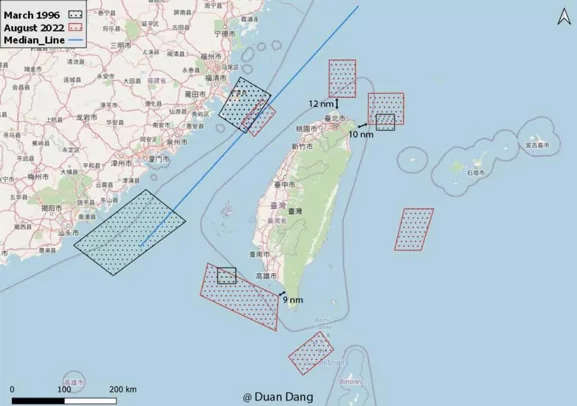Chihwei Yu

In fact, the CCP’s military tactics during the civil war share some similarities with its current Taiwan policy, particularly with regard to the so-called “Peiping Mode” (北平模式). This approach seeks to achieve its goals through a combination of deterring the opponent through superior force and employing United Front work, including deploying agents and spreading fake news to persuade opponents.
Can Blockade and Disinformation Succeed?
While more and more analysts and even some foreign officials argue that the probability of China launching an amphibious invasion of Taiwan is increasing, it would be highly irrational for the PRC to move to invade under the current conditions. Considering the risks entailed, it would be impossible for the People’s Liberation Army (PLA) to adequately prepare for an invasion without a general notification of personnel. Preparations would take at least six to ten weeks, not only because the PLA would have to concentrate its forces in southeastern China but also because Beijing would need to ensure sufficient munitions and supplies for a long fight. Furthermore, even if China could successfully launch a surprise attack without triggering global alarm, an occupation would provoke the Taiwanese population and hence, tremendously increase the cost to the CCP of governing Taiwan.
Regarding the Umbrella Movement in Hong Kong and China’s policy towards the protesters, it is unlikely that the same policy would be successful if applied to Taiwan. Moreover, the PRC’s 2019-2020 crackdown in Hong Kong was likely more heavy-handed than is widely assumed. For example, rumors have circulated that the PRC arrested college students who were protesting and transported them by train to an unknown location (Setn, November 27, 2019). Regardless, the situation the PRC confronts in Taiwan is markedly dissimilar to that in Hong Kong. In fact, if China were to take over Taiwan through military force, it would be impossible to govern the island peacefully. The population of Taiwan is nearly four times the size of Hong Kong and any aggressive actions would likely provoke a strong response from the Taiwanese people. As a result, a military invasion of Taiwan would be highly costly and unwise for China, both in terms of the significant risk involved in preparing for such an attack as well as the potential impact on China’s global reputation and the possibility of international condemnation due to human rights violations.
Lessons of 1949: Peiping Mode and China’s Current Taiwan Policy
If the risks and costs of military unification with Taiwan are deemed too high, China may eventually come to adopt a different strategy. Clues from China’s civil war between 1945 and 1949 suggest that the CCP may focus on United Front work and applying military pressure to induce Taiwan to surrender, rather than launching a full-scale invasion. The CCP’s takeover of the cities of Suiyuan, Tianjin and Peiping (Beijing) provides valuable insights. In the case of Suiyuan, the CCP agreed to maintain the status quo at the request of the KMT forces in the region, while focusing on United Front work to persuade them to surrender. In Tianjin, the CCP launched an attack on the city’s downtown area and wiped out all KMT forces, despite themselves suffering significant damage. This campaign had a significant impact on the CCP’s march to Peiping. The tactics of Peiping Mode are very similar to China’s current policy towards Taiwan, including its military activities and propaganda efforts.
Based on the history of 1948 and 1949, Peiping Mode consists of three main elements: 1) employing a deterrence strategy through superior force; 2) implementing a surrounding blockade; and 3) undertaking United Front work to undermine the adversary from within. Even though the CCP negotiated with Fu Zuoyi (傅作义), the commander of KMT forces in Northern China, from the beginning stage of the Pingjin Campaign (平津战役), it was only when the Tianjin Campaign (天津战役) ended with the CCP’s crushing victory that Fu agreed to make major concessions in the negotiations. The CCP’s victory successfully changed Fu’s attitude due to its deterrent effects. In terms of the deterrence strategy, while it may be challenging to replicate the ideal effect of the Pingjin Campaign today, China is increasing its pressure on Taiwan with daily PLA Air Force (PLAAF) and PLA Navy (PLAN) probes into the air and waters around Taiwan. These aircraft have frequently entered Taiwan’s air defense identification zone (ADIZ) and deny the existence of the median line in the Taiwan Strait with their deliberate flight routes. The increasing number of PLA aircraft and PLAN vessels and their daily closer proximity to Taiwan creates pressure similar to what people in Peiping felt in 1948.
Based on the positioning of vessels and aircraft, the recent large-scale PLA exercises this April and last August appear to be part of a broader plan to blockade Taiwan (China Brief, October 4, 2022). The exercise zones, particularly those surrounding important harbors, suggest that China is focused on restricting Taiwan’s maritime access (Xinhuanet, April 8; August 2, 2022). Additionally, the location of the exercise zone to the southeast of Taiwan may be strategically significant, as the PLA could be planning for how to prevent U.S. forces from entering the Taiwan Straits from the south. The joint naval exercise between China and Russia in December 2022, held offshore Zhejiang Province, may also play a role in China’s plan to deny intervention by U.S. forces stationed on the Korean Peninsula (China Military Online, December 21, 2022). All of these factors indicate that China is taking steps to increase its military presence in the region and to exert greater control over Taiwan, which could have significant implications for regional stability and international relations. PLA military exercise zones after the visit by U.S. Speaker Nancy Pelosi in August 2022 (source: China Times)
PLA military exercise zones after the visit by U.S. Speaker Nancy Pelosi in August 2022 (source: China Times)
 PLA military exercise zones after the visit by U.S. Speaker Nancy Pelosi in August 2022 (source: China Times)
PLA military exercise zones after the visit by U.S. Speaker Nancy Pelosi in August 2022 (source: China Times)Finally, the CCP’s United Front work may cause severe damage to Taiwan (China Brief, October 19, 2022). CCP historians admit that the deliberate spread of disinformation is a key element of United Front work. Firstly, recent news stating that U.S. President Joe Biden said, “Wait until you see our plan for the destruction of Taiwan” is a typical example of disinformation (China Times, February 21). This “news” has had a significant impact on Taiwanese society. Despite the dubious nature of these claims, Taiwanese may have become more suspicious of the U.S. due to the spread of this kind of misinformation. The effects of such fake news persist and more disinformation continues to spread on social media. For instance, an article in a U.S. military academic journal entitled “Broken Nest: Deterring China from Invading Taiwan” is being discussed on some local forums, with its arguments twisted to suggest that the U.S. will take over semiconductor giant TSMC and leave Taiwan to be destroyed (Disp BBS, April 9, 2022). [1] This type of fake news is prevalent in Taiwan’s media, including newspapers and TV programs. All in all, the spread of fake news related to the U.S. and national security may create confusion and mistrust among the Taiwanese people, which could ultimately weaken Taiwan’s ability to resist potential aggression from China.
Furthermore, the spread of fake news in Taiwan serves a more specific purpose beyond triggering suspicion towards the U.S. According to the Peiping Mode, superior force and deterrence alone cannot work without first crushing the opponent’s morale. The majority of people in Taiwan believe that Taiwan cannot protect itself without U.S. military aid due to the significant cross-Strait imbalance in military strength. Therefore, making concessions to avoid war appears more reasonable for some in Taiwan, for example, by increasing economic interdependence with China (The Storm Media, February 17). This consensus provides China with an opportunity to crush Taiwan’s morale, leading to increased numbers of people willing to accept the “one-China principle” and become more pro-China, employing its propaganda via those media outlets with investments in the Chinese market and injecting specific fake news stories, as well. Ultimately, given the growing number of pro-China individuals, China can more easily replicate the Peiping Mode in Taiwan over time.
Conclusion
China still considers the military option as a means to unify Taiwan. However, we should keep in mind that an attack on Taiwan would incur an unbearable cost and does not accord with China’s ultimate policy goals. Given these factors and the conditions in the Taiwan Straits and U.S.-China relations, Peiping Mode provides a more reasonable approach for China to achieve its goals vis-à-vis Taiwan. However, given the history of Peiping between 1948 and 1949, the CCP is unlikely to give up on the military option as a potential solution. Instead, China will invest more resources in military preparation and activities to maximize the deterrent effect and amplify the influence of fake news.
Even if we leave China’s Taiwan policy aside, the probability of war or conflict erupting from an accident in the Taiwan Strait remains high due to the lack of communication channels and mutual trust between Taipei and Beijing, as well as the ongoing confrontation between the U.S. and China. While the daily presence of PLA aircraft and vessels in the Taiwan Strait is integral to the military pressure element of China’s approach, Taiwan must respond accordingly, both in terms of defense and rhetoric. Beijing tends to interpret Taiwan’s responses negatively, and its activities towards Taiwan will likely escalate, making incidents more frequent and heightening the risk of conflict in the Taiwan Strait. The U.S. must demonstrate solid and unwavering support for Taiwan; otherwise, China will become more aggressive. Given the increasing confrontation between the U.S. and China and the declining level of mutual trust between the two countries, accidents are more likely to occur in the Taiwan Strait.
Dr. Chihwei Yu is an associate professor at the Department of Public Security, Central Police University, Taiwan, ROC, and an adjunct research fellow at the Institute for National Policy Research (INPR). He earned his Ph.D. Degree from National Taiwan University. He focuses his research on international organization, China’s foreign policy, and the regional security in East Asia.
No comments:
Post a Comment